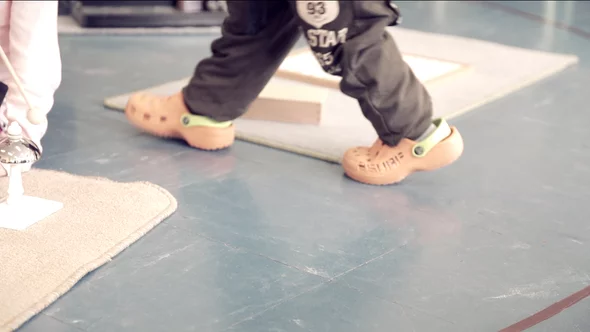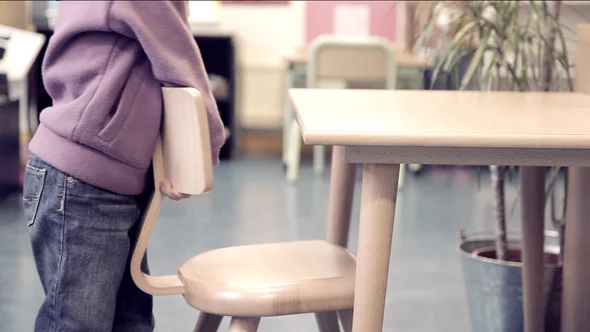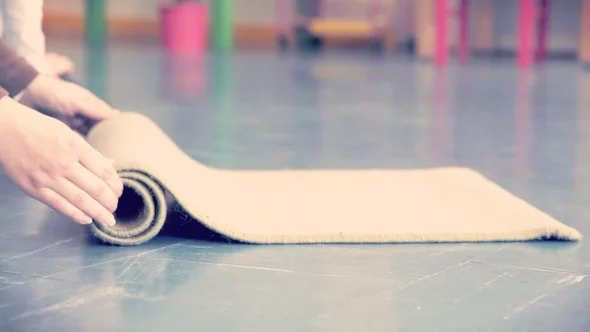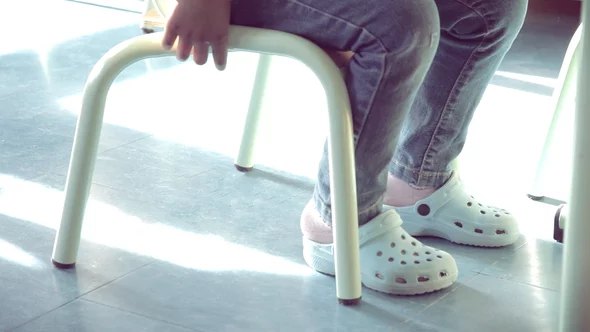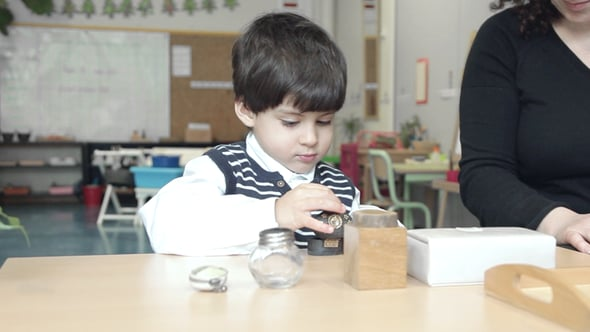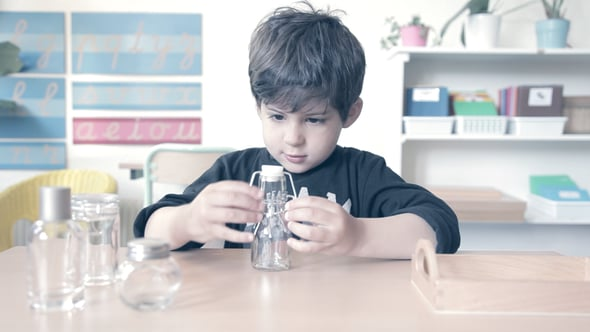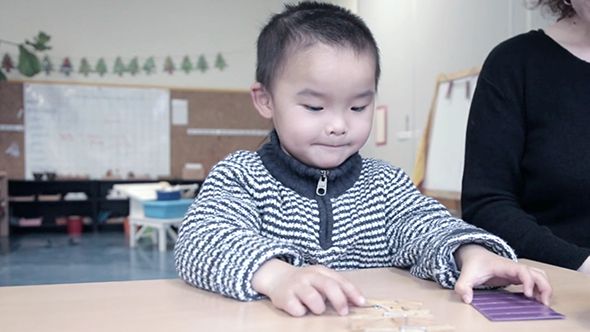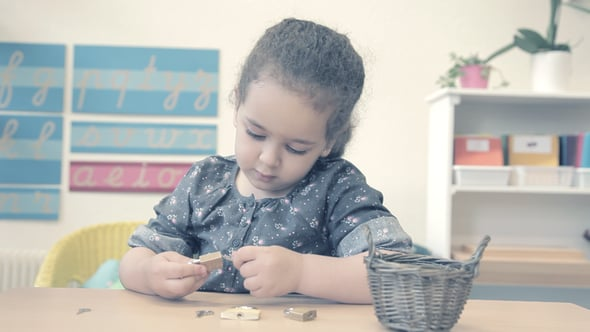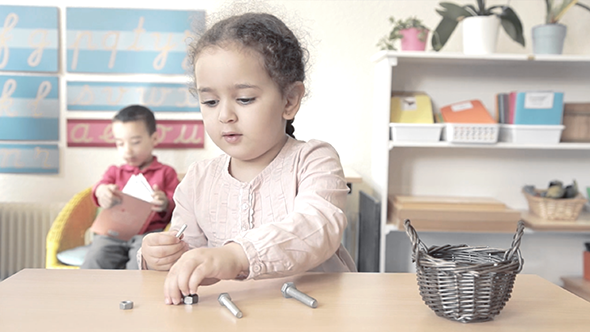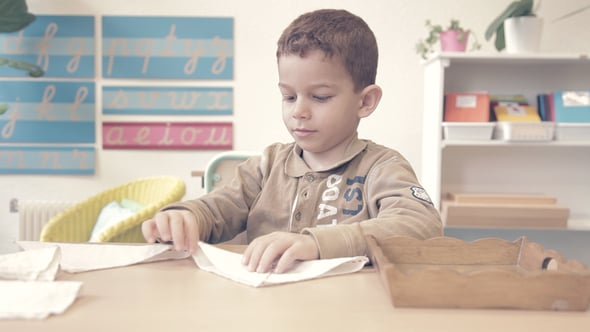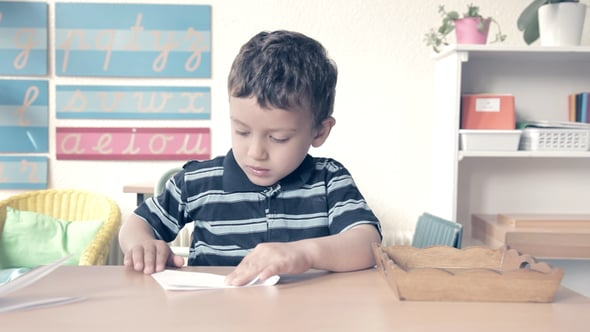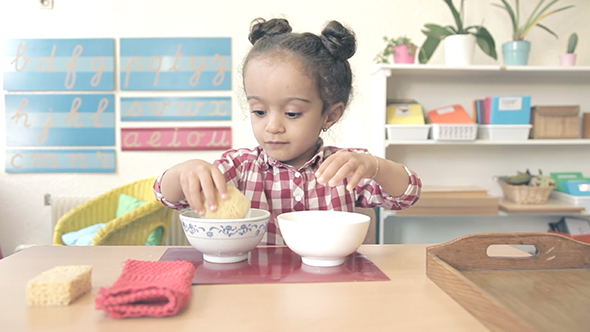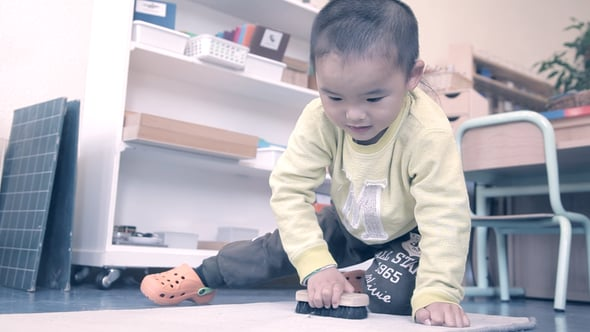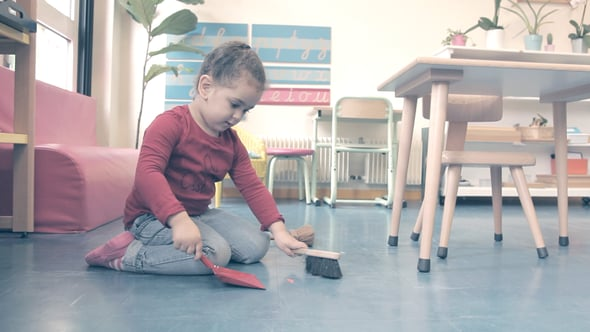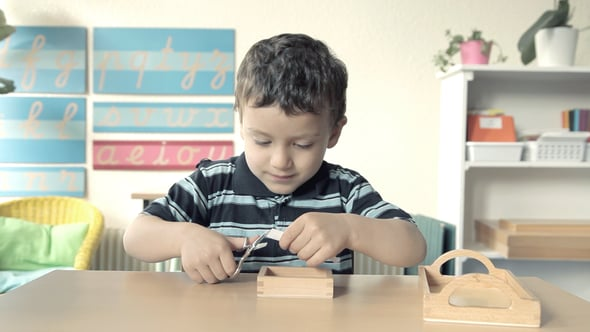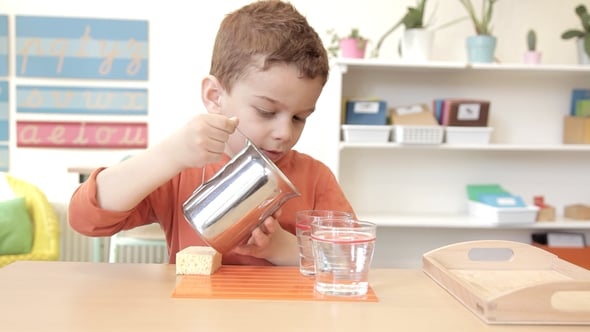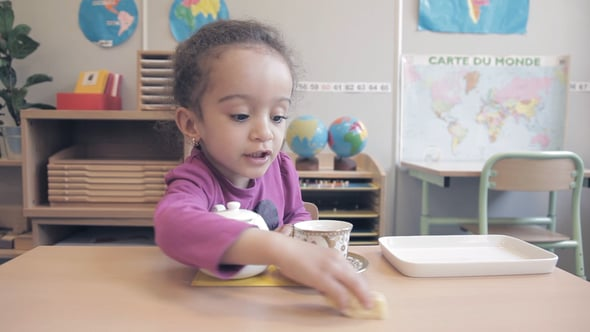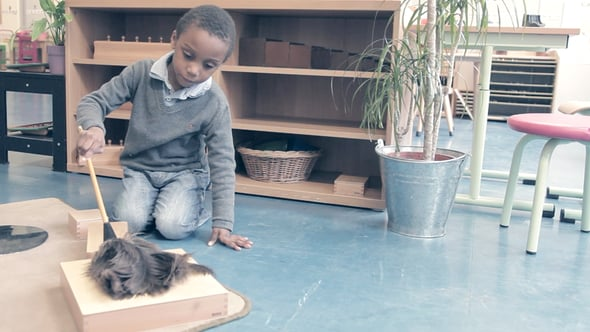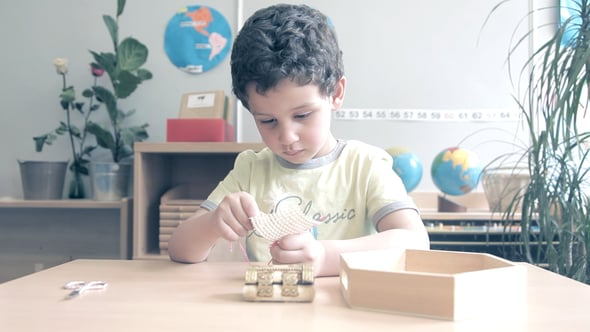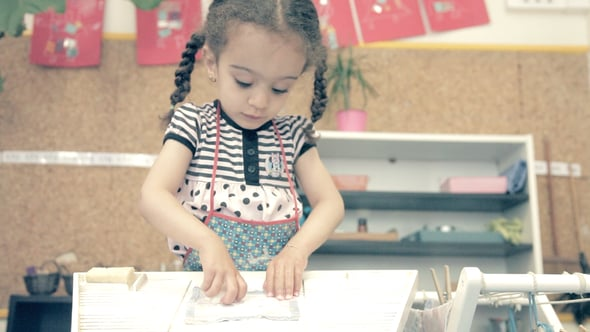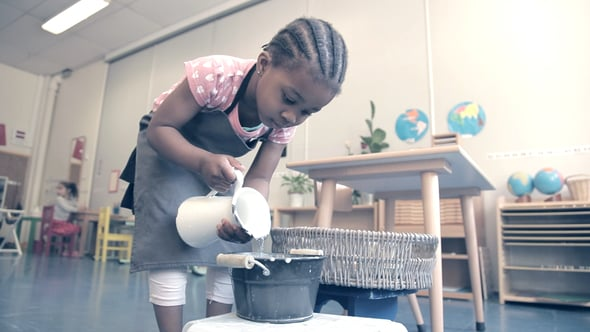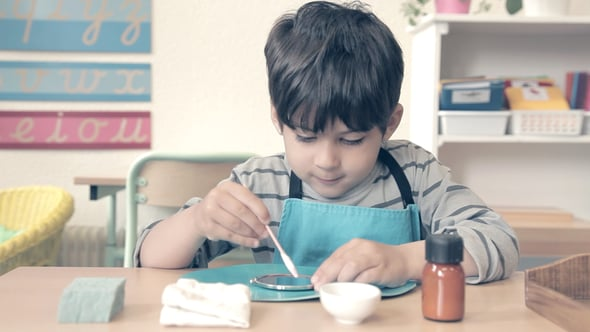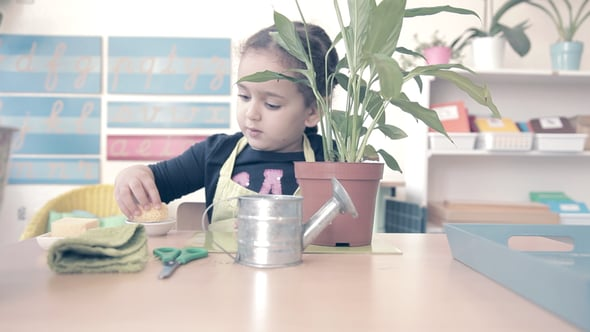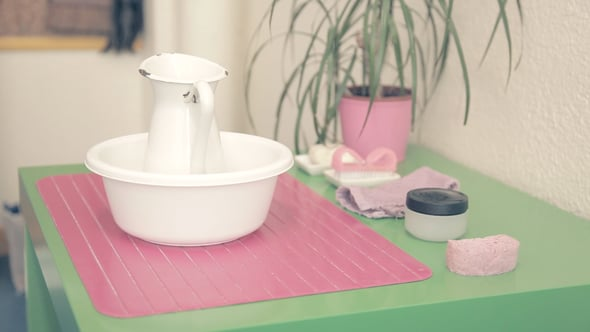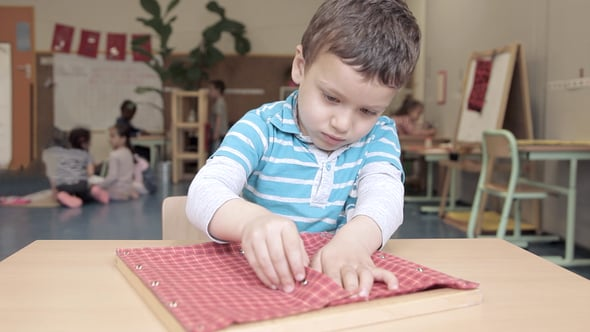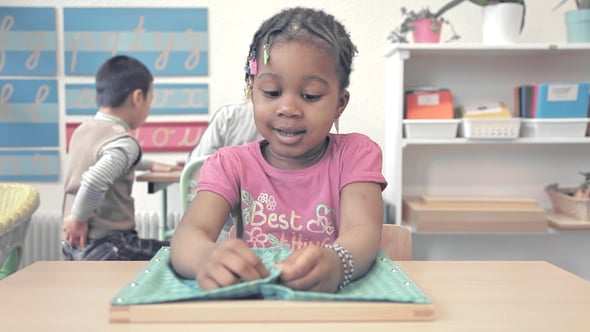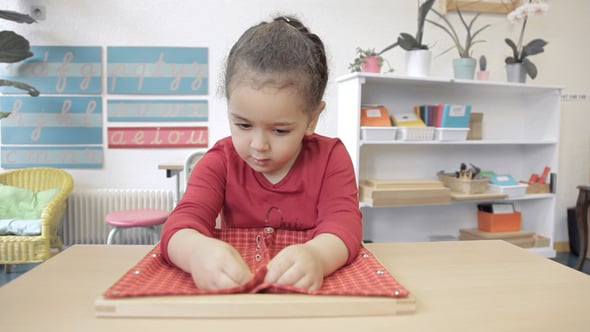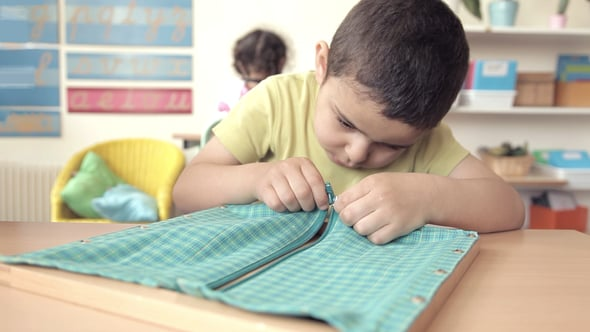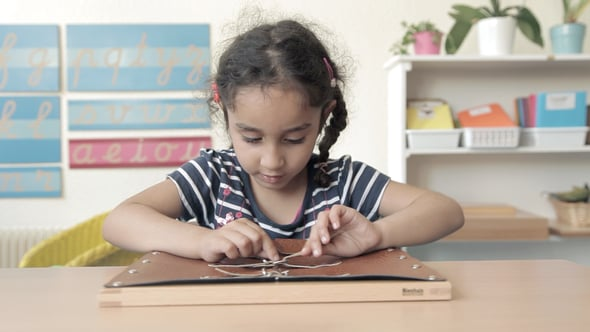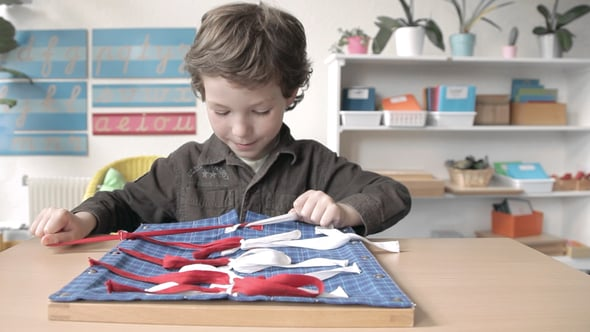Practical activities
First steps
To start with, let's show the youngest children (who are only just 2½), in a precise and ordered way, the physical motions which will help them to make confident progress on their own in their environment: how to put their shoes on themselves and tidy them away, speak quietly, open and close a door, blow their noses, sit down carefully, etc. While the teacher has to show the children these motions every day, the assistant has to do so even more often – not as a form of correction but as an amusing presentation. We suggest that you prepare these physical motions with your assistant. NB: transmitting these motions requires a lot of time. Some children will need several weeks of demonstrations and practice.
Simple activities
To begin with, we suggest you present 'simple' practical activities which focus on a particular movement - folding, cutting up, pouring out, squeezing, etc. - to give the child a chance to practise. When they begin to master these movements, you can then present more complex practical activities which require several of these movements at the same time.
Boxes
Opening and closing boxes
From age 2½.
Objectives
Principal objective - Development of executive skills
Objective formulated to the child - Opening and closing boxes
Materials
Provide several boxes which each open and close in a different way.
- State the objective verbally 'I'm going to show you how to open and close some boxes.'
- Name all the objects.
- Give an individual presentation which is precise, logical and simple.
- Give feedback on the end result 'The box isn't opening, it's properly closed.'
- Ask the child to do it.
Structure of the presentation
Bottles
Opening and closing bottles
From age 2½.
Objectives
Principal objective - Development of executive skills
Objective formulated to the child - Opening and closing bottles
Materials
Provide several bottles which each open and close in a different way.
- State the objective verbally 'I'm going to show you how to open and close some bottles.'
- Name all the objects.
- Give an individual presentation which is precise, logical and simple.
- Give feedback on the end result 'The bottle isn't opening, it's properly closed.'
- Ask the child to do it.
Structure of the presentation
Clothes pegs
Opening and closing clothes pegs
From age 2½.
Objectives
Principal objective - Development of executive skills
Objective formulated to the child - Opening and closing clothes pegs
Materials
In a basket, provide some clothes pegs and quite a rigid object to peg them to.
The object in the video is a bit of placemat.
- State the objective verbally 'I'm going to show you how to open and close some clothes pegs.'
- Name all the objects.
- Give an individual presentation which is precise, logical and simple.
- You don't need to give feedback; if the clothes peg doesn't stay in place, the child will understand on their own that it's incorrectly positioned.
- Ask the child to do it.
Structure of the presentation
Opening and closing locks
Opening and closing locks
From age 3.
Objectives
Principal objective - Development of executive skills
Objective formulated to the child - Opening and closing locks
Materials
In a basket, provide three locks of different sizes.
- State the objective verbally 'I'm going to show you how to open and close some locks.'
- Name all the objects.
- Give an individual presentation which is precise, logical and simple.
- Give feedback on the end result 'When the lock closes, you hear a click.'
- Ask the child to do it.
Structure of the presentation
Nuts and bolts
Screwing and unscrewing nuts on bolts
From age 3.
Objectives
Principal objective - Development of executive skills
Objective formulated to the child - Screwing and unscrewing nuts on bolts
Materials
In a basket, provide three bolts of different sizes and the corresponding nuts.
Make sure you have some spare nuts and bolts in your store cupboard.
- State the objective verbally 'I'm going to show you how to screw and unscrew some nuts on bolts.'
- Name all the objects.
- Give an individual presentation which is precise, logical and simple.
- You don't need to give feedback; if the nut doesn't stay on the bolt, the child will understand on their own that it's not the right nut.
- Ask the child to do it.
Structure of the presentation
Folding fabric
Folding fabric
From age 2½.
Objectives
Principal objective - Development of executive skills
Objective formulated to the child - Folding fabric
Materials
A box or a tray with four square pieces of fabric. At least one line should be sewn on each piece of fabric in the colour of your choice: one piece with a median line, one piece with two median lines, one piece with a diagonal line, and one piece with two diagonal lines.
- State the objective verbally 'I'm going to show you how to fold a piece of fabric.'
- Name all the objects.
- Give an individual presentation which is precise, logical and simple.
- Give feedback on the end result 'You can see the lines when the fabric is properly folded.'
- Ask the child to do it.
Structure of the presentation
This activity also serves as indirect preparation for the basic folds used in Origami.
Folding paper
Folding paper
From age 3.
Objectives
Principal objective - Development of executive skills
Objective formulated to the child - Folding paper
Materials
A container with square pieces of paper with the same folding lines as the 'Folding fabric' activity: one median line, two median lines, one diagonal line and two diagonal lines. A fifth type of folding is added to this activity: folding the edges towards the centre of the square. Feel free to provide the children with coloured paper and also a tray to carry the sheets of paper. Make sure you have enough spare sheets in the store cupboard for the various types of folding, because from one day to the next some children will want to repeat this activity many times. You might also wish to stick some of their foldings into their exercise books, with the date if possible, so that they can (if they want to!) see the progress they are making.
Make sure you have enough spare sheets in the store cupboard for the various types of folding, because from one day to the next some children will want to repeat this activity many times. You might also wish to stick some of their foldings into their exercise books, with the date if possible, so that they can (if they want to!) see the progress they are making.
Click here to download the file with the five types of folding which we suggest you work on with the children.

- State the objective verbally 'I'm going to show you how to fold some paper.'
- Name all the objects.
- Give an individual presentation which is precise, logical and simple.
- Give feedback on the end result 'When the paper is properly folded, the fold is on the line.'
- Ask the child to do it.
Structure of the presentation
This activity also serves as indirect preparation for the basic folds used in origami.
Squeezing a sponge
Squeezing a sponge
From age 3.
Objectives
Principal objective - Development of executive skills
Objective formulated to the child - Squeezing a sponge
Materials
On a tray, provide two medium-sized ceramic bowls, a natural sponge, a small towel and a bucket. We included a placemat to define the working zone and asked the children to do the activity on top of it. We suggest you use one main colour for this activity to help the children tidy away afterwards: the bucket, placemat and towel can all be the same colour.
Make sure you have some spare bowls in your store cupboard. You can also provide a few additional towels of the same colour in the children's store area so that they can put the dirty towel in the laundry basket when it becomes too wet and replace it on the tray with a dry towel.
- State the objective verbally 'I'm going to show you how to squeeze a sponge.'
- Name all the objects.
- Give an individual presentation which is precise, logical and simple.
- Give feedback on the end result 'There's no water on the placemat, all the water is going into the bowl.'
- Ask the child to do it.
Structure of the presentation
Note that this activity prepares the children for bigger practical activities like cleaning the table or washing laundry, because it allows them to practise the logical planning of many tasks – pouring, wringing out, squeezing, emptying water into the bucket and then into the sink, etc.
Brushing a mat
Brushing a mat
From age 3.
Objectives
Principal objective - Development of executive skills
Objective formulated to the child - Brushing a mat
Materials
One or two mat brushes.
- State the objective verbally 'I'm going to show you how to brush a mat.'
- Name all the objects.
- Give an individual presentation which is precise, logical and simple.
- Give feedback on the end result 'There's no dust left on the brush'.
- Ask the child to do it.
Structure of the presentation
Sweeping
Sweeping
From age 2½.
Objectives
Principal objective - Development of executive skills
Objective formulated to the child - Sweeping
Materials
Provide the children with a broom and a dustpan and brush.
- State the objective verbally 'I'm going to show you how to sweep.'
- Name all the objects.
- Give an individual presentation which is precise, logical and simple.
- Give feedback on the end result 'There's no more dirt on the floor.'
- Ask the child to do it.
Structure of the presentation
Cutting up
Cutting up
From age 3.
Objectives
Principal objective - Development of executive skills
Objective formulated to the child - Cutting up
Materials
On a tray, provide a small pair of scissors and a small box or dish.
On the shelf next to the tray, place a container which has various types of paper to cut up.
Here is a selection of files for use in this activity. We suggest you print them out on sheets of different colours to attract the children's attention and, in order to make cutting them up easier, we recommend that you use slightly rigid sheets. Download the five files.
Etroit One scissor cut.

Large Two scissor cuts.

Line Several scissor cuts.

Zigzag One or two scissor cuts and turning of the sheet.

Spirales Continuous scissor cuts while at the same time turning the sheet.

- State the objective verbally 'I'm going to show you how to cut up some paper.'
- Name all the objects.
- Give an individual presentation which is precise, logical and simple.
- Give feedback on what you are doing 'I'm cutting along the line.'
- Ask the child to do it.
Structure of the presentation
Pouring into a glass
Pouring into a glass
From age 3.
We suggest you present this activity when the 'Practising pouring 1 & 2' activities have already been mastered to a basic degree.
Objectives
Principal objective - Development of executive skills
Objective formulated to the child - Pouring into a glass
Materials
On a tray, provide a plastic base (we cut up a placemat), two real glasses (ideally of the type used every day in the canteen or at home) marked with a coloured line, a jug, a sponge and a bucket. It can be a good idea to use the same colour (of your choice) for the objects used in this activity (base, bucket). This enables the children to associate the objects with a particular activity and to find them easily.
Make sure you have spare glasses in your store cupboard.
- State the objective verbally 'I'm going to show you how to pour some water.'
- Name all the objects.
- Give an individual presentation which is precise, logical and simple.
- Give feedback on the end result 'The water isn't over the red mark, and there's no water on the base.'
- Ask the child to do it.
Structure of the presentation
Pouring with a teapot
Pouring with a teapot
From age 3½.
We suggest you present this activity when the 'Practising pouring 1 & 2' activities have already been mastered to a basic degree.
Objectives
Principal objective - Development of executive skills
Objective formulated to the child - Pouring with a teapot
Materials
On a tray, provide a plastic base (we cut up a placemat), a cup, a saucer, a small teapot, a sponge and a bucket. It can be a good idea to use the same colour (of your choice) for the objects used in this activity (base, bucket). This enables the children to associate the objects with a particular activity and to find them easily.
Make sure you have spare cups in your store cupboard.
- State the objective verbally 'I'm going to show you how to pour with a teapot.'
- Name all the objects.
- Give an individual presentation which is precise, logical and simple.
- Give feedback on the end result 'There's no water on the base.'
- Ask the child to do it.
Structure of the presentation
Complex activities
This type of activity engages the children enormously, because they have to draw deeply and in unison on different executive skills: they have to retain in their memories a number of stages and order them over quite a long time period; at the same time, they have to draw deeply on their inhibitory control in order to inhibit a range of physical movements and distractions; and lastly, they need to display great cognitive flexibility, because they will of course encounter a few obstacles in the course of the activity and will have to find solutions to them. This kind of 'big project', such as cleaning the table, washing the laundry or cleaning a windowpane, is therefore a powerful catalyst in the development of young children's executive skills – and that is precisely why young children adore these activities: they call on skills which are undergoing rapid development.
We urge you to treat the following presentations as a helpful guide, rather than as presentations to be imitated exactly. Just bear in mind that it is desirable to organise an activity which is practical logical, ordered and precise, with a real-world and intelligent goal which encourages the children to deploy their executive skills in unison.
Dusting
Dusting
From age 3.
Objectives
Principal objective - Development of executive skills
Objective formulated to the child - Dusting
Materials
A feather duster or a dust cloth.
Feel free to provide the children with a choice of dusters.
- State the objective verbally 'I'm going to show you how to dust.'
- Name all the objects.
- Give an individual presentation which is precise, logical and simple.
- Give feedback on the end result 'There's no more dust.'
- Ask the child to do it.
Structure of the presentation
Preparing to sew
Preparing to sew
From age 4½.
Objectives
Principal objective - Development of executive skills
Objective formulated to the child - Sewing
Materials
A tray with a box containing a needle, some thread, a pair of scissors and a threading board. In a small storage space, we suggest you leave at the children's disposal threads of different colours, of about twenty centimetres in length, and some spare threading boards. This way, when the children have sewn their thread along a line or two and don't have enough thread to continue, they can get some more on their own, and maybe choose another colour. When they put the activity away, make sure that the children always replace the thread and threading board on the tray.
Feel free to then provide a range of thread boards with holes of various sizes and a range of trays, each with the appropriate needle and thread. Note that the logical progression from this activity would be to offer the older children the chance to sew together bits of cloth, to sew on buttons, etc.
- State the objective verbally 'I'm going to show you how to sew.'
- Name all the objects.
- Give an individual presentation which is precise, logical and simple.
- Give feedback on the end result 'The thread is in a straight line.'
- Ask the child to do it.
Structure of the presentation
Washing laundry
Washing laundry
From age 3½.
Initially, the children will be very disorganised, and that's perfectly normal. They won't retain the various stages, they'll pour water on their feet, etc. This is the moment when you should present the activity, rather than when they're 'ready' not to spill water everywhere and to perform the stages in a logical order. This activity should therefore be presented during the first term of the first year, after the various pouring activities (so that they are familiar with pouring water), and in particular to the most 'agitated', least attentive and most 'disorganised' children. This activity draws on, and develops, young children's executive skills to a significant degree. For your own part, you'll need patience and inhibitory control - as far as is possible and appropriate, of course.
Objectives
Principal objective - Development of executive skills
Objective formulated to the child - Washing laundry
Matériel
A basin, a plastic bowl, a bucket, a drying rack, clothes pegs, a basket of dirty laundry (containing cloths, serviettes and tea towels used by the children), a waterproof apron, a bar of soap, a sponge and perhaps a scrubbing brush. Ideally, you should provide objects of the same colour for this activity to help guide the children.
You could also suggest that the children fold up the clean and dry laundry from the previous day. The younger children really like this complementary activity.
- State the objective verbally 'I'm going to show you how to wash the laundry.'
- Name all the objects.
- Give an individual presentation which is precise, logical and simple.
- Give feedback on the end result 'The cloth is clean and the floor is dry.'
- Ask the child to do it.
Structure of the presentation
When the child has finished, show them how to fold up their apron and, if necessary, how to mop up the water on the floor with a mop and bucket (used by the children in the activities involving water).
Cleaning the table
Cleaning the table
From age 3½.
Initially, the children will be very disorganised, and that's perfectly normal. They won't retain the various stages, they'll pour water on their feet, etc. This is the moment when you should present the activity, rather than when they're 'ready' not to spill water everywhere and to perform the stages in a logical order. This activity should therefore be presented during the first term of the first year, after the various pouring activities (so that they are familiar with pouring water), and particularly to the most 'agitated', least attentive and most 'disorganised' children. This activity draws on, and develops, young children's executive skills to a significant degree. For your own part, you'll need patience and inhibitory control - as far as is possible and appropriate, of course.
Objectives
Principal objective - Development of executive skills
Objective formulated to the child - Cleaning the table
Materials
On a tray or in a basket, provide a jug, a sponge, a brush and a bar of soap. We advise you to place the sponge, brush and bar of soap on small dishes and to place the tray or basket on a small stool so that it is within the child's reach while they're cleaning the table. The activity also involves a plastic bowl, a bucket and an apron. Make sure you put the plastic bowl on top of something so that it is within easy reach. The bucket can be placed on the floor. Ideally, you should provide objects of the same colour for this activity to help guide the children.
- State the objective verbally 'I'm going to show you how to clean the table.'
- Name all the objects.
- Give an individual presentation which is precise, logical and simple.
- Give feedback on the end result 'The table is clean and dry.”
- Ask the child to do it.
Structure of the presentation
Cleaning a mirror
Cleaning a mirror
From age 3½.
This activity requires the children to master a basic range of skills such as 'opening and closing a bottle', 'pouring' and 'folding'. This activity should therefore be presented to the children after activities like pouring, the bottles and folding.
Objectives
Principal objective - Development of executive skills
Objective formulated to the child - Cleaning a mirror
Materials
Put various mirrors at the children's disposal on a shelf. On a tray, provide an opaque cleaning liquid (the opacity is good for spotting errors because the child can see that traces remain and can correct their work), a small dish, a square cloth, a sponge, a little stick with a cotton tip, a base to work on and an apron. Instead of a cotton-tipped stick, you could use a very small roller or something similar, but we would advise you against using cotton buds. This is because we believe it is important to provide the children with objects in a context which makes sense culturally, so that their intelligence can structure itself in an ordered way: each thing has its rightful place and should be used within its cultural context. And since cotton buds are used to clean one's ears rather than to clean a mirror, we feel that this object would be out of place in this activity. Ideally, you should provide objects of the same colour for this activity to help guide the children.
- State the objective verbally “I'm going to show you how to clean a mirror.”
- Name all the objects.
- Give feedback on the end result 'You can see yourself perfectly in the mirror.”
- Ask the child to do it.
Structure of the presentation
Maria Montessori also got children to polish brass objects, but in today's cultural context, that activity no longer makes much sense, and so we decided not to use it. Our approach was to only offer the children practical activities which are relevant in the contemporary world and that they can observe in their environment.
Looking after plants
Looking after plants
From age 4½.
This activity requires the children to master a basic range of skills such as 'pouring', 'folding', 'cutting up', 'sponging' and 'squeezing'. This activity should therefore be presented to the children after the activities involving pouring, folding, cutting up and 'Squeezing the sponge'.
Objectives
Principal objective - Development of executive skills
Objective formulated to the child - Looking after plants
Materials
Robust indoor plants with broad leaves (Spathiphyllum, Rubber, Gardenia, etc.). A tray with a container in which there is: a small dish with a sponge for washing the leaves, a small watering can, a small dish with a sponge for sponging up the water on the table, a pair of scissors, a towel, an apron and a bucket. It can be a good idea to use the same colour for the objects used in this activity (container, bucket, towel and apron). This enables the children to associate the objects with a particular activity and to find them easily.
We suggest that you make available to the children in a small storage space some spare towels which are clean and dry. When they tidy away the activity, make sure they always put a new towel on the tray and they put the used towel in the dirty laundry basket used for the 'Washing the laundry' activity.
- State the objective verbally 'I'm going to show you how to look after a plant.'
- Name all the objects.
- Give an individual presentation which is precise, logical and simple.
- Give feedback on the end result 'If you pour in too much water, it flows out the bottom of the pot. When you've washed the leaves, they shine.'
- Ask the child to do it.
Structure of the presentation
We suggest you guide the children on how to choose the plants they are going to look after. For example, if the earth is already wet, it means the plant has been tended to recently and it would be better if they chose another plant.
Washing one's hands
Washing one's hands
From age 3½.
Objectives
Principal objective - Development of executive skills
Objective formulated to the child - Washing one's hands
Materials
If you decide to organise this activity on a table, you'll need a jug so that they can go and get some water, a bowl the child can wash their hands in, and a bucket with which the child can empty the dirty water from the bowl into the sink. If you're lucky enough to have a small washbasin in the classroom (in addition to the main sink used by all the children for classroom activities), you can set it up specially for this activity and so will not need the materials we've just listed.
In either case, we suggest you provide the children with: a waterproof apron, a bar of soap in a small dish, a nail brush, a sponge to wipe the sink or the table when the activity has been completed, a small towel for drying their hands and possibly some hand cream. Ideally, you should provide objects of the same colour for this activity to help guide the children.
- State the objective verbally 'I'm going to show you how to wash your hands.'
- Name all the objects.
- Give an individual presentation which is precise, logical and simple.
- Give feedback on the end result 'Your hands smell nice and the table is clean.'
- Ask the child to do it.
Structure of the presentation
Dressing frames
Dressing frames are an easy means for the children to practise (as much as they need to) the various daily routines for getting (un)dressed. These activities are therefore a useful complement to getting (un)dressed on their own every day, but should in no way serve as a replacement for that: it is essential to allow the children to get dressed and undressed on their own every day.
You should adapt yourself to the needs of each child: some will need to see you do all the knots yourself before trying it for themselves, while others will only need to see you tie one or two knots – let the child guide you. Needless to say, we also suggest that you present the tying of knots in the way that is the most natural for you personally.
Popper buttons
Popper button dressing frame
From age 2½.
Objectives
Principal objective - Development of executive skills
Objective formulated to the child - Doing up and undoing popper buttons
Materials
A wooden frame covered with two lengths of fabric which can be attached with popper buttons.
- State the objective verbally 'I'm going to show you how to do up and undo popper buttons.'
- Name the popper buttons. In order to make this new vocabulary stick and to check whether the child is already familiar with this type of button, ask them: 'Have you already seen popper buttons? On what clothes? On a shirt?'
- Give an individual presentation which is precise, logical and simple.
- Give feedback on the end result 'The popper buttons are properly closed. The two bits of fabric are attached.”
- Ask the child to do it.
Structure of the presentation
Buttons 1
Button dressing frames
From age 2½.
Objectives
Principal objective - Development of executive skills
Objective formulated to the child - Buttoning up and unbuttoning
Materials
A wooden frame covered with two lengths of fabric which can be attached with buttons.
- State the objective verbally 'I'm going to show you how to button up and unbutton.'
- Name the buttons. In order to make this new vocabulary stick and to check whether the child is already familiar with this type of button, ask them: 'Have you already seen buttons? On what clothes? On a cardigan?'
- Give an individual presentation which is precise, logical and simple.
- Give feedback on the end result 'It's buttoned up.' 'The two bits of fabric are attached.'
- Ask the child to do it.
Structure of the presentation
Buttons 2
Button dressing frame 2
From age 2½.
Objectives
Principal objective - Development of executive skills
Objective formulated to the child - Buttoning up and unbuttoning
Materials
A wooden frame covered with two lengths of fabric which can be attached with buttons.
- State the objective verbally 'I'm going to show you how to button up and unbutton.'
- Name the buttons. Check whether the child knows the vocabulary by asking: “Have you already seen buttons? On what clothes? On a cardigan?'
- Give an individual presentation which is precise, logical and simple.
- Give feedback on the end result 'It's buttoned up.' 'The two bits of fabric are attached.'
- Ask the child to do it.
Structure of the presentation
Zips
Zip dressing frame
From age 3.
We recommend that you present the button dressing frames before this one.
Objectives
Principal objective - Development of executive skills
Objective formulated to the child - Doing up and undoing a zip
Materials
A wooden frame covered with two lengths of fabric which can be attached with a zip.
- State the objective verbally 'I'm going to show you how to do up and undo a zip.'
- Name the zip. In order to make this new vocabulary stick and to check whether the child is already familiar with zips, ask them: 'Have you already seen zips? On what clothes? On trousers?'
- Give an individual presentation which is precise, logical and simple.
- Give feedback on the end result 'It's done up.' 'The two bits of fabric are properly attached.'
- Ask the child to do it.
Structure of the presentation
Buckles
Buckle dressing frame
From age 3½. We recommend you offer this dressing frame after they've done the buttons and the zip.
Objectives
Principal objective - Development of executive skills
Objective formulated to the child - Doing up and undoing buckles
Materials
A wooden frame covered with two lengths of leather or rigid fabric which can be attached with buckles.
- State the objective verbally 'I'm going to show you how to do up and undo buckles.'
- Name the buckles. In order to make this new vocabulary stick and to check whether the child is already familiar with buckles, ask them: 'Have you already seen buckles? On what clothes? On shoes?'
- Give an individual presentation which is precise, logical and simple.
- Give feedback on the end result 'It's done up.' ' The two bits of fabric are attached.'
- Ask the child to do it.
Structure of the presentation
For this dressing frame, unlike the others, we decided to present just one buckle to the child: we undid it and then did it up again and let the child do the same with the other buckles, starting with the top one. We stayed by their side to give them any help they needed during their first attempts. In our experience, when all the buckles are undone one after the other and then all done up again, it becomes a very lengthy activity which loses its appeal and sense for the children, who prefer to undo and do up the buckles one after another. But you should of course choose to do this activity in the way that you think is best, based on your experiences with the children. It doesn't really matter how you decide to present this activity – the important thing is that the child gets the chance to practise undoing and doing up buckles in an orderly and intelligent way.
Knots
Knot dressing frame
From age 4½.
Given that this is more difficult, we advise you to present this dressing frame when the child has mastered the other dressing frames.
Objectives
Principal objective - Development of executive skills
Objective formulated to the child - Tying and untying knots
Materials
A wooden frame covered with two lengths of fabric which can be attached with knots.
- State the objective verbally 'I'm going to tie and untie knots.'
- Name the knots. To make sure this new vocabulary sticks, ask them: 'Have you already seen knots? On what clothes? On shoes?'
- Give an individual presentation which is precise, logical and simple.
- Give feedback on the end result 'The two bows are the same size and the knot is nice and straight.'
- Ask the child to do it.
Structure of the presentation
You should adapt yourself to the needs of each child: some will need to see you do all the knots yourself before trying it for themselves, while others will only need to see you tie one or two knots – let the child guide you. Needless to say, we also suggest that you present the tying of knots in the way that is the most natural for you personally.
When the child is fully engaged in the activity, don't be afraid to gradually withdraw to let them get on with it on their own. However, during the initial presentations, you'll no doubt have to stay by their side to help them to concentrate and then to help them to tidy away the materials once the activity is over. Explain to them that, from now on, they can use these materials when they like and for however long they like.


